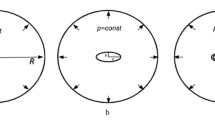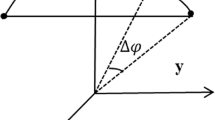The investigation is aimed at the improvement of the performance properties of the slotted shell elastic elements. The latter components are the open shell, deformable filler, and rigid pistons. In a good design, the elastic elements with an open shell possess high retention along with comparably low rigidity and the required level of vibrations damping. At present, there is theoretical background for the calculation of the elastic elements with an open cylindrical shell of a stable thickness. The problem of the open shell section's effect on the material consumption, strength, and deformation properties of the elastic element has not been investigated. The procedure of efficient design of the full-strength section of the elastic element with the filled slotted shell, which is in bending, has been developed. Some justified assumptions, which allow one to perform the analytical investigations, have been introduced at the problem formulation stage. Among them are the hypotheses on the inextensibility of the middle shell surface, neglection of friction on the contact surface, and small shear modulus of the filler material. The authors have formulated and solved the one-dimensional task on the interaction of the deformable weakly compressible filler with an open cylindrical shell with the azimuth variable thickness. The full strength of the shell is taken as a key criterion of the construction of the optimum section of the elastic element. The analytical expression has been obtained for the determination of the open shell thickness. The comparison of material consumption and compliance of the full-strength elastic element with similar characteristics of the elastic element with the slotted shell is performed. It is established that the compliance of the proposed elastic element exceeds the prototype compliance by 70%, while the material consumption of the shell with the variable thickness is 57% lower as compared with the corresponding value for the shall with constant thickness.



Similar content being viewed by others
References
Z. D. Xu, Z. H. Chen, X. H. Huang, et al., “Recent advances in multi-dimensional vibration mitigation materials and devices,” Front. Mater., 6, 1–14 (2019), https://doi.org/10.3389/fmats.2019.00143.
V. M. Shopa, I. P. Shats’kyi, O. O. Bedzir, and A. S. Velychkovych, Contact Interaction between the Slotted Shells with Deformable Bodies [in Ukrainian], IFNTUNG, Ivano-Frankivsk (2015).
G. S. Pisarenko, V. V. Matveev, and A. P. Yakovlev, Methods for Determining the Vibration Damping Behavior of Elastic Systems [in Russian], Naukova Dumka, Kiev (1976).
V. V. Matveev and A. P. Zin’kovskii, “Methods of determining the characteristics of vibration damping in elastic elements of systems with many degrees of freedom,” Strength Mater., 13, No. 4, 500–507 (1981), https://doi.org/10.1007/BF00762507.
V. V. Matveev, Damping of Vibrations of Deformable Bodies [in Russian], Naukova Dumka, Kiev (1985).
Ya. G. Panovko, Mechanics of Deformable Solid. Modern Concepts, Errors and Paradoxes [in Russian], Nauka, Moscow (1985).
I. G. Tokar’, A. P. Zinkovskii, and V. V. Matveev, “On the problem of improvement of the damping ability of rotor blades of contemporary gas-turbine engines,” Strength Mater., 35, No. 4, 368–375 (2003), 10.1023/A:1025838324211.
A. Velichkovich, T. Dalyak, and I. Petryk, “Slotted shell resilient elements for drilling shock absorbers,” Oil Gas Sci. Technol., 73, 1–8 (2018), https://doi.org/10.2516/ogst/2018043.
A. A. Bedzir, I. P. Shatskii, and V. M. Shopa, “Nonideal contact in a composite shell structure with a deformable filler,” Int. Appl. Mech., 31, No. 5, 351–354 (1995), https://doi.org/10.1007/BF00846842.
V. M. Shopa, I. P. Shatskii, and I. I. Popadyuk, “Elementary calculation of structural damping in shell springs,” Sov. Eng. Res., 9, No. 3, 42–44 (1989).
S. V. Velichkovich, I. I. Popadyuk, I. P. Shatskii, and V. M. Shopa, “Structural hysteresis in a shell-type vibration damper with distributed friction,” Strength Mater., 23, No. 3, 279–281 (1991), https://doi.org/10.1007/BF01194768.
I. Shatskyi, I. Popadyuk, and A. Velychkovych, “Modelling of energy dissipation in shell dampers,” in: Proc. of 23rd Int. Conf. Engineering Mechanics 2017 (May 15–18, 2017, Svratka, Czech Republic), Brno University of Technology, Institute of Solid Mechanics, Mechatronics and Biomechanics, Svratka (2017), pp. 870–873.
I. Shatskyi, I. Popadyuk, and A. Velychkovych, “Hysteretic properties of shell dampers”, in: J. Awrejcewicz (Ed.), Dynamical Systems in Applications, Springer Proceedings in Mathematics & Statistics, vol. 249, Springer, Cham (2018), pp. 343–350, https://doi.org/10.1007/978-3-319-96601-4_31.
I. I. Gerega, I. S. Lozovoi, M. R. Kozul’kevich, and V. M. Shopa, “Generalized mathematical model of the multiple-mass dynamical system of a vibration machine,” Sov. Appl. Mech., 27, No. 12, 1219–1225 (1991), https://doi.org/10.1007/BF01301510.
A. Velychkovych, I. Petryk, and L. Ropyak, “Analytical study of operational properties of a plate shock absorber of a sucker-rod string,” Shock Vib., 2020, Article ID 3292713 (2020), https://doi.org/10.1155/2020/3292713.
V. G. Rekach, Guide to Solving Problems of Applied Theory of Elasticity [in Russian], Librokom, Moscow (2010).
Author information
Authors and Affiliations
Corresponding author
Additional information
Translated from Problemy Prochnosti, No. 2, pp. 82 – 87, March – April, 2021.
Rights and permissions
About this article
Cite this article
Shats’kyi, I.P., Shopa, V.M. & Velychkovych, A.S. Development of Full-Strength Elastic Element Section with Open Shell. Strength Mater 53, 277–282 (2021). https://doi.org/10.1007/s11223-021-00286-y
Received:
Published:
Issue Date:
DOI: https://doi.org/10.1007/s11223-021-00286-y




